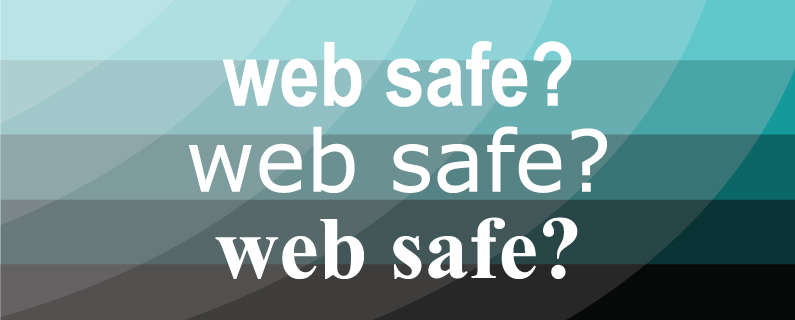
Once upon a time, not all that long ago, web designers were limited to certain colors and fonts. Designers were constrained in their choices because the average person who would view the site was limited by technology. Monitors could only differentiate 256 colors (only 216 were consistent across all web browsers) and computers could only display fonts which were actually installed on an individual machine.
Web Safe Color
Designers worked within the limitations. In a way, it was fairly easy to design back then. There was no need to agonize over different shades of blue since the subtle differences would be lost when you switched to web safe colors. Fonts were selected mostly for readability. After awhile selecting web safe colors and fonts as we began a project became second nature.
The technology has improved, but the habits persist. Today’s monitors and browsers can display a much wider range of colors, but many designers still hold on to the standard 216 web safe colors they have used for years. The formulas are easy to remember, but the trade off is a limited color palette which often means your brand will look like 100 other brands out there. The subtle differences let you stand out, so go ahead, experiment with a wider color pallet.
Web Safe Fonts
Like web safe colors, there were limitations on font choices. Designers selected a web safe font from a relatively small list of fonts found typically on both Windows and Mac computers. The list included: Arial, Trebuchet, Verdana, Times Roman and Georgia.
This limited choice was necessary because when a web page loaded, the browser would attempt to write text to the screen using a specific font. If the font was not available on the computer then the browser wouldn’t be able to display the font correctly. Common substitutions were made and the sites would be readable, but just like color, there was no point in selecting interesting fonts, since they wouldn’t display correctly on most machines.
While the typical computer is still fairly limited in the number of fonts installed, designers can now use fonts found on the web to bring more interesting fonts to their design. Essentially in the programming, the designer must simply tell the site where to look for the fonts.
Where can you pull fonts from? Well, you can install the specific font on your site, but you don’t need to. Our favorite resource is actually Google Fonts. With hundreds of free font choices, you can dramatically change the look of your website in just a few clicks. And if your logo was designed with some obscure custom font, you can look for it on Adobe Typekit. To use these fonts you will need a subscription for the life of your website, so it may make sense to look for something similar on Google before purchasing a subscription.
Your Website Can Look Like Your Brand
Even on a limited budget, you do not have to settle for a cookie cutter site with a limited range of color and font choices. If you have established branding there is no need to compromise. Select the colors and fonts which are consistent with your established brand guidelines. And if you are launching a new brand, choose interesting fonts and look at colors which are not part of the standard 216 web safe colors for a website which looks as distinctive as you want your brand to be.
[su_email_signup]Roundpeg is an Indianapolis graphic design firm.
